At Origins, we are constantly on the lookout for emerging consumer markets with the potential to generate billion-dollar companies.
In recent months, one market has captured our attention with its immense growth potential, high consumer engagement, and untapped opportunities: the running market. With over 600 million runners worldwide, a strong willingness to pay, and robust stickiness metrics, the running industry is ready to be disrupted and poised to produce its next unicorn.
Our team has been looking closely at this emerging wave, holding over 50 calls with founders and reviewing more than 200 pitch decks from startups in the space.
The conclusion?
The running market is not only booming but also ripe for disruption. Many of these startups are capturing specific niches, but none have yet built the all-encompassing platform that could truly dominate the market.
Why Running? A Market with Limitless Potential
The running market boasts a total addressable market of over 600 million runners worldwide, with 150 million running at least twice a month in the Western world. In line with the skyrocketing growth in the number of runners, race participants (doubled in the last 6 years), running brands, running podcasts, running influencers, and running clubs (59% increase in running club members in 2024), the market today includes over 30 million active subscribers to running apps. Running is driven by strong tailwinds such as health and wellness trends, the rise of community-focused experiences, and the increasing availability of advanced fitness technology.
At Origins, we've built a strong thesis around scalable consumer business models, leveraging insights gathered from analyzing over 5,000 consumer businesses. Our deep dive into this expansive landscape has revealed a tremendous business opportunity within the running market underpinned by three major levers driving the potential for profitable and scalable billion-dollar ventures:
Three Powerful Market Levers
Infinite TAM: The number of people starting to run or aiming for their first marathon is ever-growing.
High Willingness to Pay: 50% of runners earn $100K+ per year, and 25% earn $150K+ per year.
Strong Stickiness: 50% of runners have been running for over 3 years, and 30% for more than 5 years. Running is not just a hobby—it's an addiction.
The 4 Key Pillars Shaping the Running Market
The running market is riding an unprecedented wave of growth and enthusiasm. With streets filled with runners, clubs multiplying, and marathon participation at all-time highs, the momentum is undeniable. Yet, despite this booming market, the space remains highly fragmented. Current solutions either focus narrowly on training programs—often limited, generic, and inflexible—or fall short in building a truly integrated community experience. There is no all-in-one platform that brings together training, social engagement, data-driven insights, and seamless race registration in a holistic way.
The opportunity for disruption is immense. The market is craving a unifying force—a platform that can consolidate these disparate experiences, create a vibrant sense of belonging, and establish a true winner-takes-all brand. The stage is set for new $1 billion companies to emerge within the next five years, capturing the passion, loyalty, and purchasing power of the global running community.
1. Transforming Performance and Race Preparation: Training Programs
Effective training programs are at the core of running success, helping runners achieve their goals, whether it's completing a first 5K or setting a new marathon PB. Companies like KipRun, Runna, Campus, and Coopah have established strong brands by offering structured training solutions in apps. KipRun, the free Decathlon app, supports 15% of Paris Marathon finishers, highlighting its accessibility and impact. Runna ($5M Seed round with JamJar, Venrex, Eka Venture and Creator Venture in november 2023) and Coopah (Seed round in January 2025 with DMG Ventures), both VC-backed players, are expanding rapidly in the US and UK, while Campus.Coach is bootstrapped and gaining traction in France.
These players have individually showcased strong growth in ARR and have confirmed valuable partnerships with brands or races, demonstrating the potential for multiple players in the market.
The healthy LTV/CAC ratios in this segment highlight the potential for strong unit economics with high retention numbers and scalable subscription models.
Despite these successes, many current programs still lack true personalization and adaptability. With 50% of runners facing injuries yearly and 3 out of 4 novice runners quitting due to a lack of motivation or inconsistent schedules, the market clearly needs a solution that blends technology, flexibility, and personalization. The next billion-dollar opportunity lies in providing dynamic, adaptable training that meets individual needs while fostering community-driven support.
2. Running as a Team Sport: The Social Aspect
Running has evolved into a social experience that blends fitness, community, and culture. With 55% of runners feeling more motivated when running with others, clubs like Midnight Runners (18 cities worldwide, 10k+ active members), Lunge Run Club, and Mikkeller RC (30k+ members each) are at the forefront of this shift, offering unique experiences that go beyond running, such as social events, brewery meetups, dating and community activities.
Beyond the clubs themselves, media platforms and content creators, including Runner’s World, The Running Channel, and influential podcasts, enrich the ecosystem by providing valuable content and fostering a deeper sense of connection among runners. They offer everything from training tips and race strategies to inspiring stories that amplify the voices of everyday runners and elite athletes. The convergence of physical meetups and digital content is reshaping running into a fully immersive lifestyle, where every run contributes to a broader journey of learning, sharing, and growth. The potential to further merge the social and educational aspects of running is immense, offering a platform where every run is part of a broader, more meaningful journey.
3. The Data-Driven Edge: Analytics and Performance Insights
The data-driven edge in the running market is transforming how runners, from beginners to seasoned marathoners, approach their training and performance. Today, runners are increasingly turning to advanced analytics and performance insights to understand every aspect of their training. Platforms and tools like Garmin, Whoop, Coros, or Apple Watch offer detailed metrics on heart rate, cadence, recovery times, glucose levels, and predictive performance modeling. With 93% of training app users relying on tracking watches, data-driven insights are not just a trend but a core component of the running experience. This data revolution is making even novice runners interested in understanding their performance, transforming casual jogs into purposeful training sessions. These insights help runners not only track their progress but also adapt their training plans based on performance trends, injury risks, and fitness improvements.
The power of analytics extends to digital platforms where numbers meet community. Apps like Nike Run Club and Strava, with its 100 million+ users, have shown how analytics combined with social features can drive engagement. These apps transform raw metrics into visual stories, allowing runners to not only track their pace and distance but also share their achievements within a vibrant community, fostering a sense of accountability, motivation, and shared purpose.
While Strava undeniably pioneered this fusion of data and community, its evolution has been surprisingly modest. Despite being a unicorn with millions of dedicated users, Strava has made minimal advancements in user interface, app features, and monetization strategies over its 15-year history. The platform remains a stronghold for performance tracking but lacks the dynamic, community-driven features that could truly revolutionize the running ecosystem. In our view, Strava has only scratched the surface of what's possible. As the running market surges forward, there is a compelling opportunity to build a platform that not only tracks performance but also weaves data, social connection, and community into a seamless and transformative experience for every runner.
4. Beyond the Finish Line: Race Search and Bibs Marketplace
The running market doesn't end at the finish line—in fact, it's just the beginning. Race registration platforms and bibs or equipment marketplaces are gaining momentum as a critical component of the running ecosystem. Companies like Let’s Do This ($60M Series B funding), Miles Republic, and Finishers (€3.5M funding each) are capitalizing on the demand for race participation, which has doubled in the past six years.
The appeal of this market goes beyond mere registration. Bibs marketplaces serve as a natural gateway to upsell additional services—from tailored training programs to specialized running gear. Companies like i-run, a €500M sports equipment platform, demonstrate the significant commercial potential when race registration is combined with retail opportunities. Additionally, memorabilia and merchandise tied to races present further avenues for revenue, tapping into the strong emotional connection runners often develop with their events.
By offering an integrated experience—from the initial race search to crossing the finish line and beyond—these platforms are capturing runners' attention. The convergence of race logistics, retail, and community building within these ecosystems not only enhances the runner's journey but also cements these companies as indispensable players in the broader running landscape.
The Untapped Opportunity: A Holistic Platform
With a sticky user base, high ARPU potential, and a growing TAM, the running market is positioned for a billion-dollar outcome. The consumer behavior shift towards health and fitness, combined with strong unit economics, makes this the ideal time for investment.
Despite the running market's size, fragmentation is evident.
No single platform offers an end-to-end experience, from training to social engagement, data analytics, bibs purchase and more down the line.
The current landscape is full of niche million-dollar opportunities, but the winning formula still remains to be built in the Running World.
At Origins, we believe that the next billion-dollar startup will emerge from this space, leveraging the four key pillars to create a fully integrated platform that transforms running from a solitary sport into a vibrant, social, and data-driven experience. For investors, the message is clear: Now is the time to lace up and join the race to back the future leader of the running market.
As the market surges, we are more excited than ever to back founders who are thinking bigger, bolder, and aiming to build the category-defining company in running.


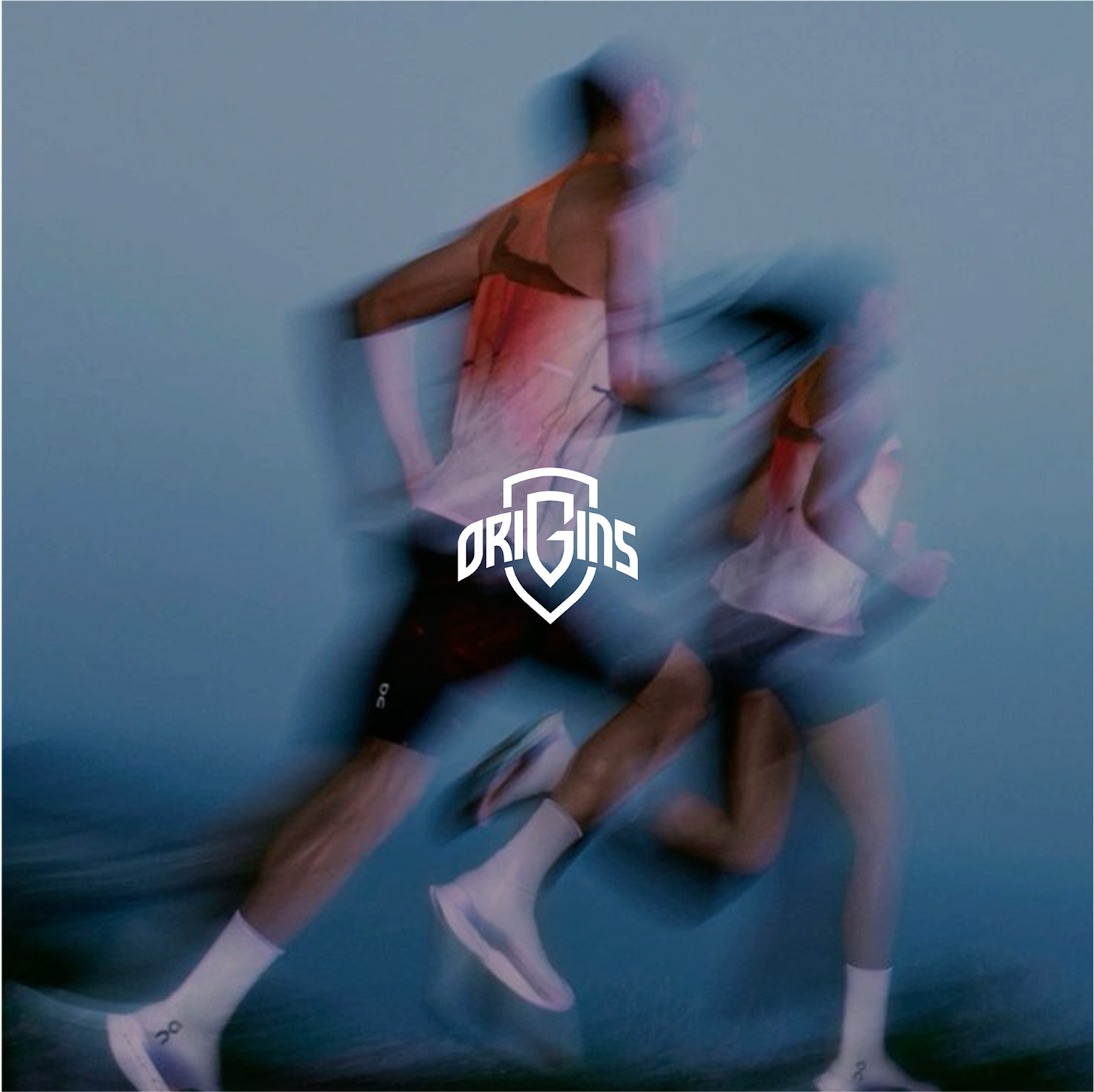

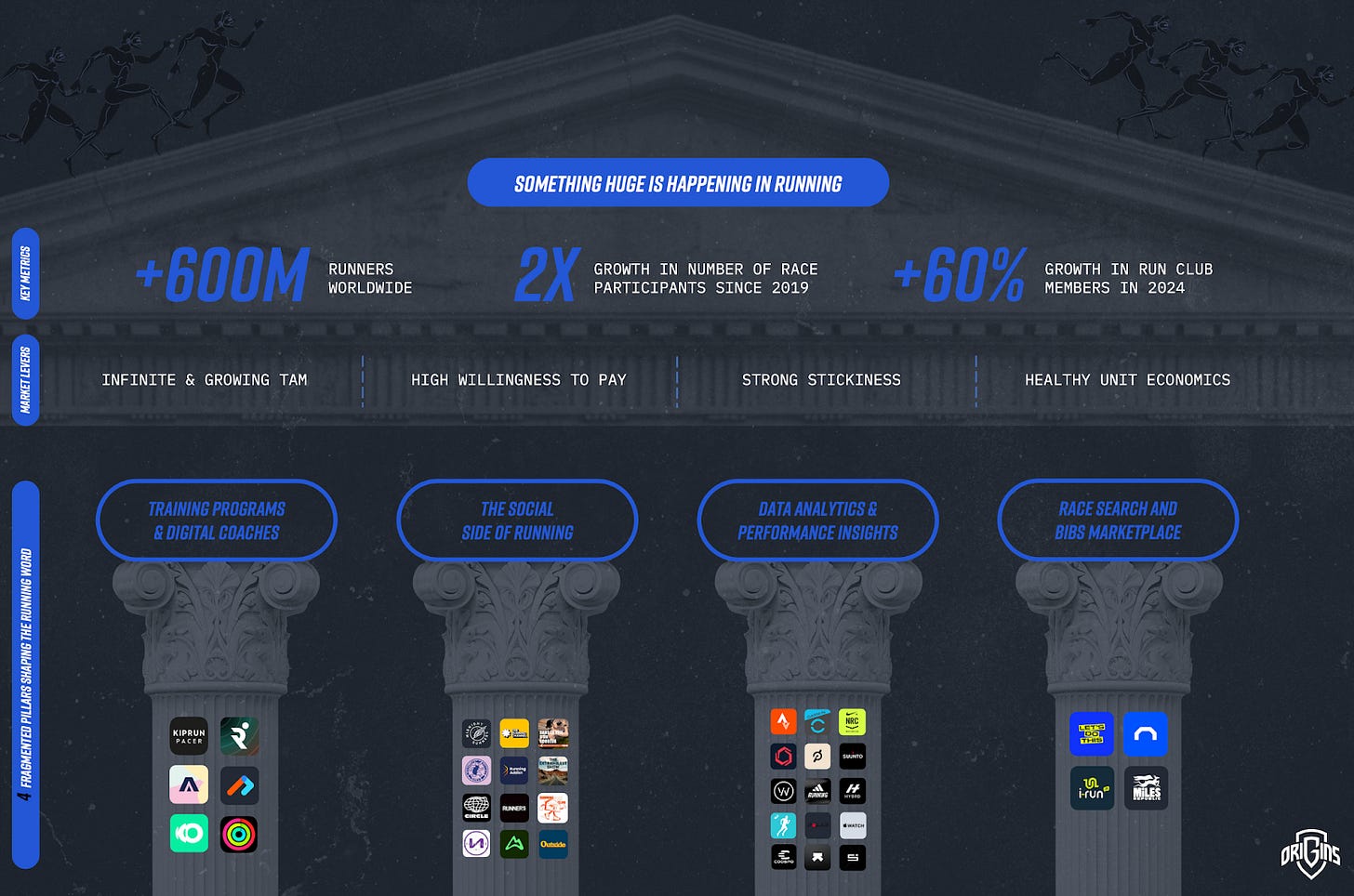
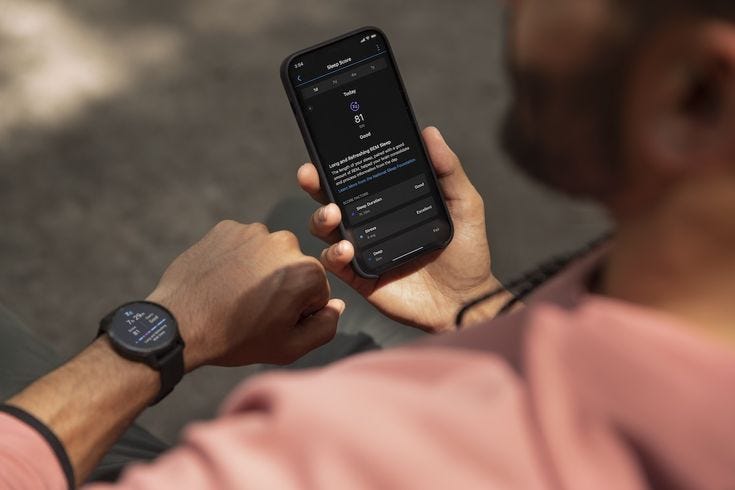

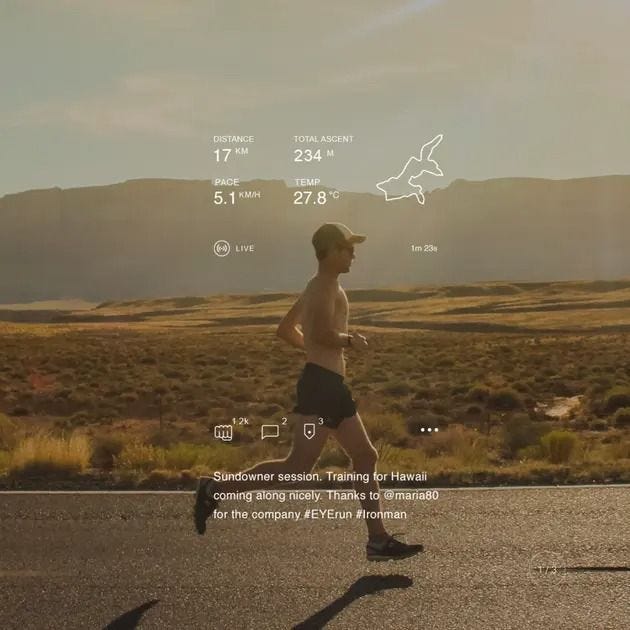
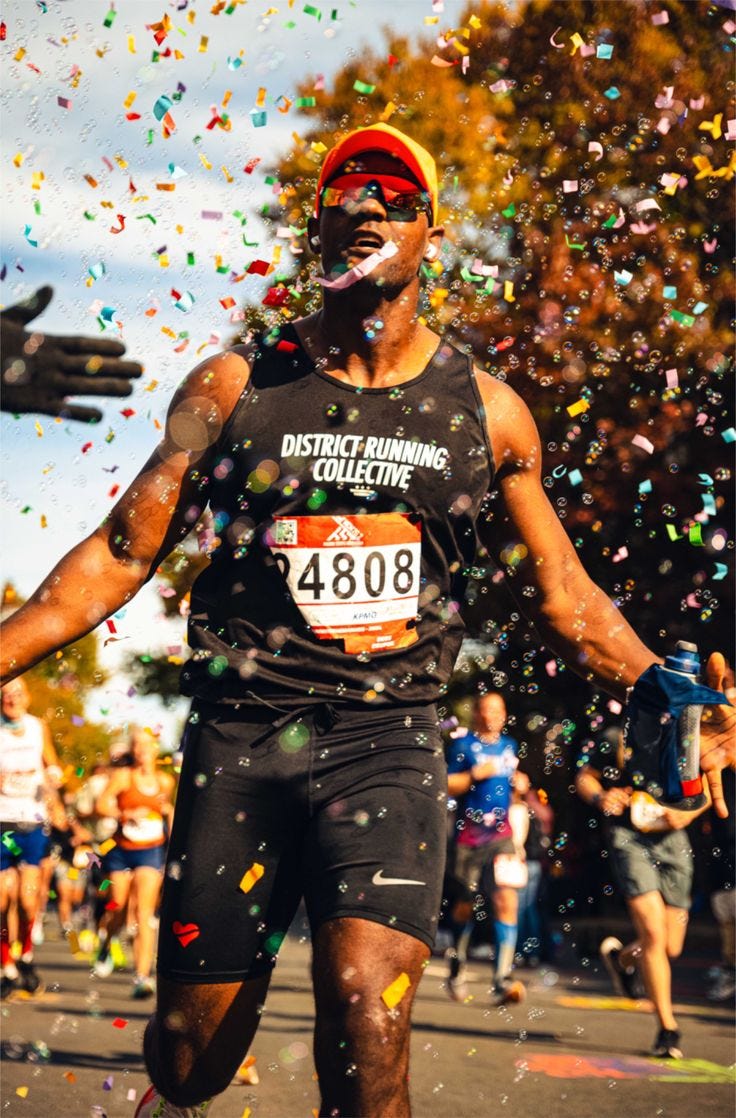

Running is the new Streetwea. Great post!